This website uses cookies so that we can provide you with the best user experience possible. Cookie information is stored in your browser and performs functions such as recognising you when you return to our website and helping our team to understand which sections of the website you find most interesting and useful.
Efficient Energy Management and Energy Saving with a BESS (Battery Energy Storage System)
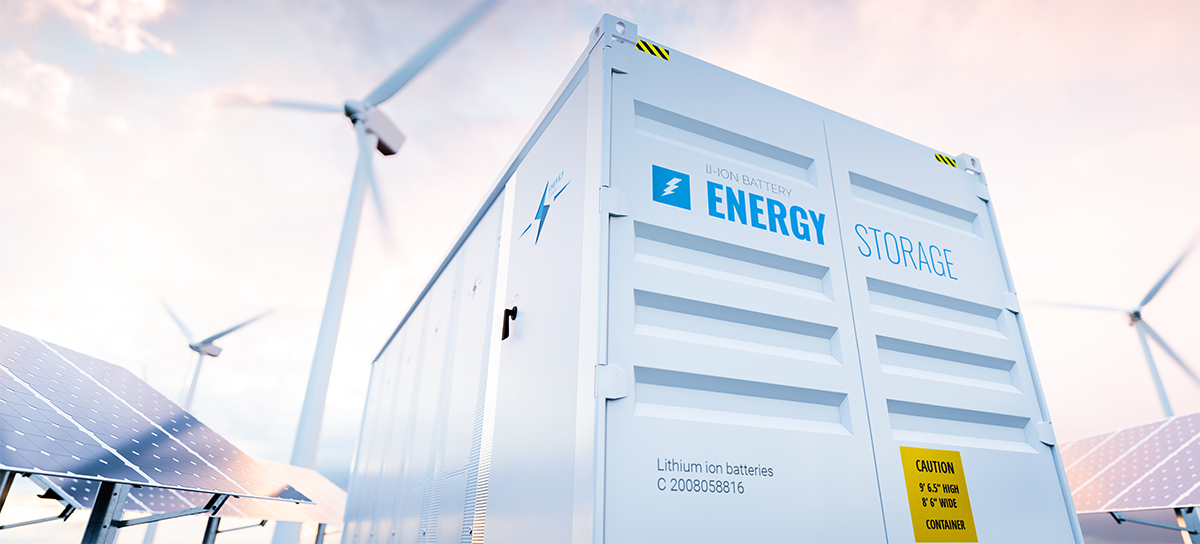

Andrey Solovev
Chief Technology Officer, PhD in Physics and Mathematics

Anna Petrova
Writer With Expertise in Covering Electronics Design Topics
- Looking Inside a BESS: What a BESS Is and How It Works
- BESS Types and Alternatives
- Lithium-Ion (Li-Ion) Batteries
- Lead-Acid (PbA) Batteries
- Nickel-Cadmium (Ni-Cd) Batteries
- Sodium-Sulfur (Na-S) Batteries
- Flow Batteries
- BESS’s Coming to Your Aid
- Load Management (Energy Demand Management)
- Energy Time-Shift (Arbitrage)
- Backup Power
- Black-Start Capability
- Frequency Control
- Renewable Energy Integration
- Transmission and Distribution (T&D) Deferral
- Microgrids
- BESS: To Buy or Not to Buy
- Building a BESS: Pros and Cons
- Conclusion
Smart energy consumption, cost-cutting, resilience, resource-saving, environmental efficiency—this is not a complete list of benefits offered by a battery energy storage system (BESS). With a wide range of power and storage capacity, BESSs vary from small-sized household devices to large-scale systems used for utilities and industrial applications. The number of battery-powered energy storage systems (BESS) installed in the US increased by 80% in 2022. Nowadays, large-scale BESSs have been operating all over the world, including the United States, Australia, the United Kingdom, Japan, China, and many other countries. This article gives clear answers to all W and H questions about battery storage technology, including what it is, why, and where you can use it. We’ll also brief you on off-the-shelf and custom-made BESSs, specifying the strengths and weaknesses of both solutions.
- Looking Inside a BESS: What a BESS Is and How It Works
- BESS Types and Alternatives
- Lithium-Ion (Li-Ion) Batteries
- Lead-Acid (PbA) Batteries
- Nickel-Cadmium (Ni-Cd) Batteries
- Sodium-Sulfur (Na-S) Batteries
- Flow Batteries
- BESS’s Coming to Your Aid
- Load Management (Energy Demand Management)
- Energy Time-Shift (Arbitrage)
- Backup Power
- Black-Start Capability
- Frequency Control
- Renewable Energy Integration
- Transmission and Distribution (T&D) Deferral
- Microgrids
- BESS: To Buy or Not to Buy
- Building a BESS: Pros and Cons
- Conclusion
Looking Inside a BESS: What a BESS Is and How It Works
A BESS is an energy storage system (ESS) that captures energy from different sources, accumulates this energy, and stores it in rechargeable batteries for later use. Should the need arise, the electrochemical energy is discharged from the battery and supplied to homes, electric vehicles, industrial and commercial facilities.
A BESS is a compound system comprising hardware components along with low-level and high-level software. The main BESS parts include:
- A battery system. It contains individual battery cells that convert chemical energy into electrical energy. The cells are arranged in modules that, in their turn, form battery packs.
- A battery management system (BMS). A BMS ensures the safety of the battery system. It monitors the condition of battery cells, measures their parameters and states, such as state-of-charge (SOC) and state-of-health (SOH), and protects batteries from fires and other hazards.
- An inverter or a power conversion system (PCS). This converts direct current (DC) produced by batteries into alternating current (AC) supplied to facilities. Battery energy storage systems have bi-directional inverters that allow for both charging and discharging.
- An energy management system (EMS). This is responsible for monitoring and control of the energy flow within a battery storage system. An EMS coordinates the work of a BMS, a PCS, and other components of a BESS. By collecting and analyzing energy data, an EMS can efficiently manage the power resources of the system.
Depending on its functionality and operating conditions, a BESS can also include a range of safety systems, such as a fire control system, a smoke detector, a temperature control system, cooling, heating, ventilation, and air conditioning systems. The safety systems have their own monitoring and control units that provide conditions necessary for the safe operation of a BESS by monitoring its parameters and responding to emergencies.
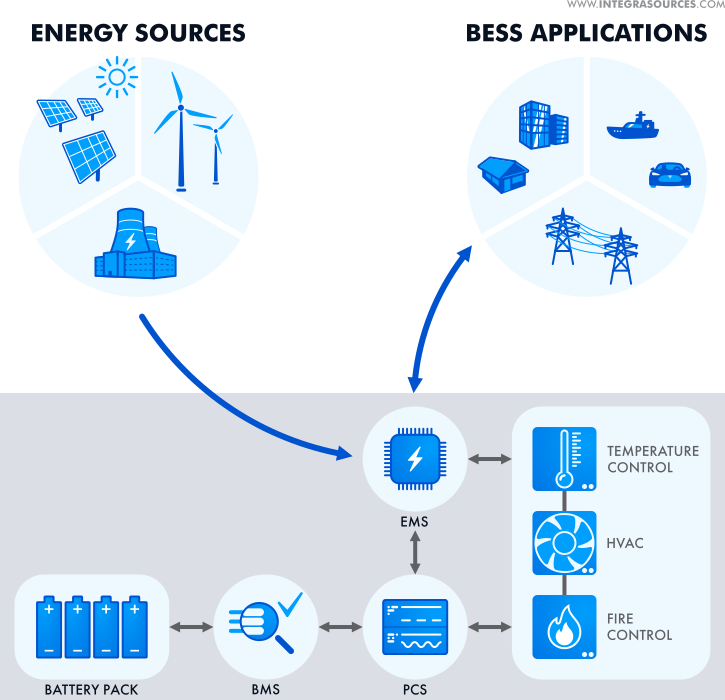
Apart from electronics, complex BESSs rely on robust software solutions. For example, state-of-the-art systems use machine learning algorithms to optimize energy management. Estimating battery states and characteristics with high accuracy requires reliable algorithms and mathematical models built within BMS software development.
In sum, a BESS collects energy from an electricity grid or renewable power sources, such as solar and wind, and stores it using battery storage technology. Then, batteries discharge and release the energy when necessary—during peak demands, power outages, and in a variety of other applications.
BESSs can accommodate different batteries, including lithium-ion, lead-acid, nickel-cadmium batteries, and others—we’ll elaborate on them later in the article. Every battery type has certain technical specifications that designate BESS uses and affect the efficiency of battery energy storage. The principal battery characteristics embrace:
- Storage capacity. This is the amount of electric charge stored by a battery or the amount of electricity available in a BESS.
- Power. This parameter determines the amount of power supplied by a battery or the output power that a BESS can provide.
- Round-trip efficiency. This displays the ratio of energy delivered by a battery during discharge to the energy supplied to the battery during a charge cycle.
- Depth of Discharge (DoD). This shows the percentage of energy discharged from a battery relative to its total capacity.
- Lifetime. This can be defined as the number of charge and discharge cycles of a battery or the amount of energy that a battery can supply during its lifetime (battery throughput).
- Safety. This is an important characteristic that shows the battery’s compliance with safety requirements, for example, in terms of the battery chemistry.
In addition to the above battery specifications, storage battery systems have other characteristics that describe their performance. For example, response time is the time a BESS needs to move from the idle state and start working at full power. Ramp rate is the rate at which the system can increase or decrease its power output—ramp it up or down, respectively.
BESS Types and Alternatives
BESSs vary depending on the electrochemistry or battery technology they use. Let’s look at the main BESS battery types and opportunities they offer for battery storage solutions.
Lithium-Ion (Li-Ion) Batteries
According to the 2021 report prepared by the US Energy Information Administration (EIA), over 90% of a large-scale battery energy storage systems in the USA were powered by lithium-ion batteries. The current global statistics are pretty much the same. This type of rechargeable battery is widely popular in electric vehicles, consumer electronics, and portables, such as smartphones, laptops, tablets, and cameras. Li-ion battery chemistries comprise lithium cobalt oxide, lithium manganese oxide, lithium iron phosphate, lithium nickel manganese cobalt oxide (NMC), and others. The advantages of a Li-ion battery make it one of the leading technologies facilitating the storage of energy. The global lithium-ion battery market is projected to triple by 2030, reaching $278 billion. It’s light and compact, has high capacity and energy density, low maintenance, and a long lifetime. In addition, lithium-ion batteries are easily and quickly charged and have a low self-discharge rate. The weak points of this battery technology include high cost, inflammability, and intolerance to extreme temperatures, overcharge, and overdischarge.
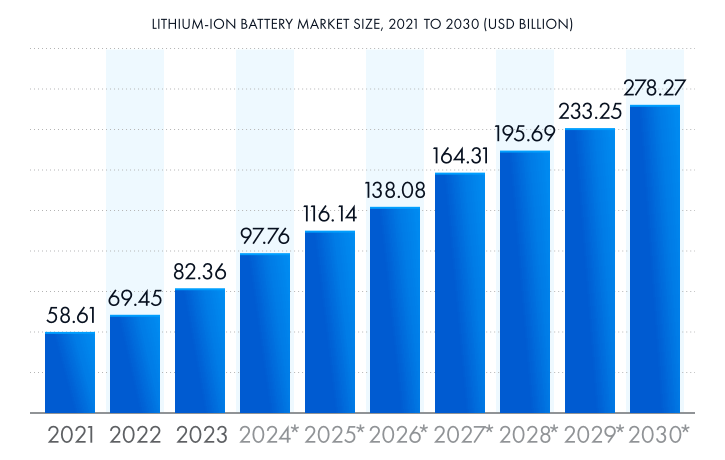
Lead-Acid (PbA) Batteries
A lead-acid battery is the oldest battery technology and is also one of the cheapest and most available solutions that find use in automotive and industrial applications as well as power storage systems. PbA batteries are highly recyclable and can operate effectively at both high and low temperatures. Valve-regulated lead-acid (VRLA) batteries are more suitable for power storage solutions than their older counterparts—flooded lead-acid batteries—as they have a longer lifetime, higher capacity, and easier maintenance. Slow charging, heavyweight, and low energy density are among the major drawbacks of this battery technology.
Nickel-Cadmium (Ni-Cd) Batteries
This battery type prevailed in the market of wearable electronics until Li-ion batteries entered the game. Ni-Cd batteries have many configurations, they are inexpensive, easy to ship and store, and highly resistant to low temperatures. The technology is behind its competitors in energy density, self-discharge rate, and recycling. Nickel-metal hydride (Ni-MH) batteries use the same component as Ni-Cd technology—nickel oxide hydroxide (NiO(OH)). However, the Ni-MH battery chemistry provides better characteristics, such as higher capacity and energy density.
Sodium-Sulfur (Na-S) Batteries
A sodium-sulfur battery is a cost-effective technology based on molten salt. The advantages of Na-S batteries involve high energy and power density, a long lifetime, and stable operation under extreme ambient conditions. Nevertheless, this battery technology has a limited application area because of high operating temperatures (not less than 300oC) and sensitivity to corrosion. In addition, sodium is a hazardous component that is highly flammable and explosive. Sodium-sulfur batteries are well-suited for standalone energy storage applications integrated with renewable power sources.
Flow Batteries
Unlike conventional rechargeable batteries in which energy is stored in solid electrode material, flow batteries store energy in liquid electrolyte solutions. The most common flow battery type is the vanadium redox battery (VRB). The other types consist of zinc-bromine, zinc-iron, and iron-chromium chemistries. Despite their low energy capacity and low charge/discharge rate, flow batteries have several important advantages, allowing them to hold a large market share in on-grid and off-grid energy storage systems, including large-scale applications. These benefits involve an extremely long lifespan (up to 30 years), high scalability, fast response time, and a low risk of fires because flow batteries contain non-inflammable electrolytes.
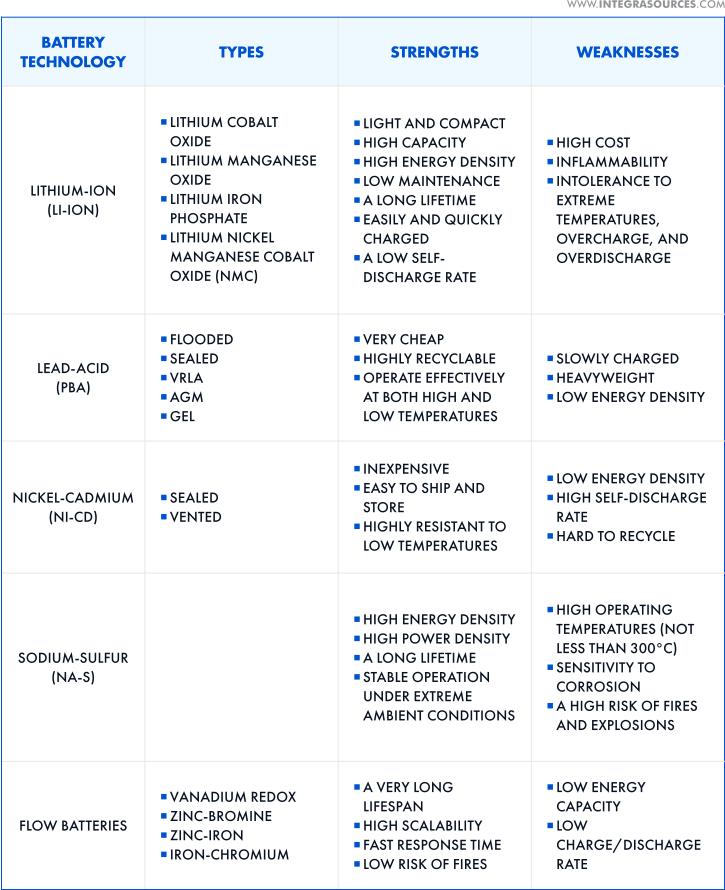
As of 2020, BESSs accounted for 7.5 % of the global energy storage capacity, significantly less than pumped-storage hydro. According to The Business Research Company, the battery energy storage market size is expected to reach $13.8 billion at 25.7% CAGR globally by 2027. Given the availability, efficiency, and latest advances in electrochemical storage technologies, a BESS is anticipated to be an energy storage leader in the years ahead. However, alternative solutions can go up against battery power storage systems, getting the upper hand in some applications. Here are the main BESS competitors:
- Pumped-storage hydroelectricity (PSH). As estimated by the International Hydropower Association (IHA), PSH systems store up to 9,000 GWh of electricity globally, taking up over 94% of the world’s energy storage capacity. In PSH, energy is generated by water that spins turbines when flowing down from a higher tank to a lower reservoir. This ESS can offer vast storage capacity at a reasonable price, meeting the needs of larger electricity networks. The biggest challenge with pumped hydro storage systems is that building them takes years and this needs hefty investments.
- Compressed air energy storage (CAES). This type of ESS uses energy to compress and store air in an underground reservoir. When the need arises, the released air produces electricity by rotating air turbines. CAES systems are effectively used in production and mining industries. However, implementing this technology can be problematic for some applications, especially residential solutions.
- Flywheel energy storage (FES). Applying energy to a flywheel increases its speed by far, generating rotational or kinetic energy which is stored and released later. FES systems are notable for their longevity (up to decades), easy maintenance, and fast response time. But they can only operate for short periods.
- Thermal energy storage (TES). This ESS type can store thermal energy collected from an array of sources, including water, rocks, and molten materials—salt, silicon, and aluminum. TES systems have the potential to be widely used with renewable energy sources in heating and cooling applications.
- Potential energy storage or mechanical gravity energy storage. The idea behind this ESS is to elevate heavyweights, such as concrete blocks, and drop them down when energy needs to be released. The technology is far from mainstream as of yet, but it could be promising for the energy storage market once it’s well-tuned.
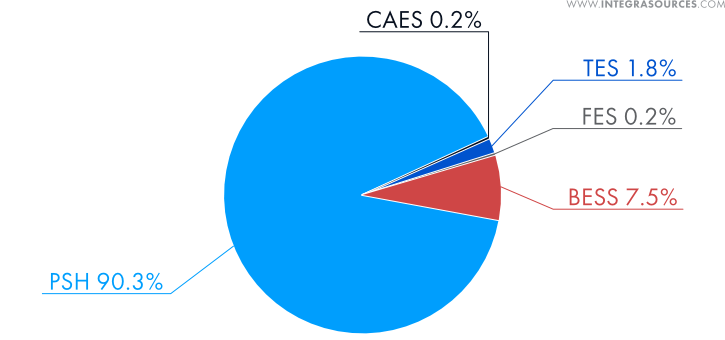
Alternative energy storage technologies have already been available for the past few years. Some of them are already up and running, while others are still in the works. The sure thing about all of them is the need for reliable machine learning and artificial intelligence solutions. These would automate operations, reduce maintenance expenses, and ensure smooth performance with minimum human input.
BESS’s Coming to Your Aid
Choosing batteries for energy storage can be beneficial for several reasons. First off, battery storage ideas have no limits regarding location—you don’t need to provide huge water tanks or underground air reservoirs. Owing to its availability and flexibility, a BESS can fit in well with applications that require varying power and storage capacity levels. Moreover, modern battery technologies tilt toward light weight, cost-efficiency, safety, and environmental friendliness. Let’s consider the use cases of a battery energy storage system and the essential problems it can solve.
Load Management (Energy Demand Management)
BESSs help balance loads between on-peak and off-peak times. Electricity demands may vary depending on the day, time, season, and other factors. The higher the demand, the higher the electricity cost and vice versa—pricing gets lower during off-peak hours. By accumulating energy when the demand is low and discharging it in peak periods, battery storage solutions enable users to save on electricity tariffs (peak shaving).
Energy Time-Shift (Arbitrage)
As mentioned above, electricity prices fluctuate at different times, having both rises and falls. Battery energy storage systems allow for energy time-shifting—energy is purchased at a low price during off-peak periods and sold or used when the price increases. Thus, irrespective of the season and electricity demand, BESSs can equalize energy prices and minimize risks.
Backup Power
A BESS can supply backup power in case of an electricity grid failure until complete power restoration. Larger storage capacity and integration with renewable energy sources enable BESSs to back up energy for longer periods. By operating as an uninterruptable power supply (UPS), a commercial battery storage solution can be a time and money saver as it eliminates downtime.
Black-Start Capability
A BESS can replace a diesel or natural gas generator used by power plants to restore power generation after blackouts by leveraging its black-start capabilities. Based on battery storage, power systems can restart after a total shutdown without using external electricity networks. The fast response time of a BESS helps systems recover in the shortest possible time.
Frequency Control
Battery storage systems can regulate frequency in the grid, making sure its value lies within the required range. If the amount of generated power disagrees with the actual electricity demand, the frequency can either exceed or fall below its nominal value. Such discrepancies may result in temporary disconnections, power failures, or blackouts. BESSs can immediately react to power interruptions, providing sub-second frequency response, and stabilize the grid.
A BESS can likewise ensure voltage stability, maintaining its level within the specified range.
Renewable Energy Integration
Integrating battery energy storage systems with intermittent renewable energy sources opens the door to inexpensive electricity continuously available to on-grid, off-grid, and hybrid systems. More recently, clean energy has gained popularity as an economically viable and eco-friendly alternative to fossil fuels. According to Statista, renewable energy sources (hydro, wind, solar, bioenergy and other renewables) accounted for 30% of global electricity production in 2022. Moreover, it is projected to reach 45% by 2040. The proliferation of renewable energy-enabled storage solutions is extensively supported and incentivized by governments through subsidies and lower tax rates.
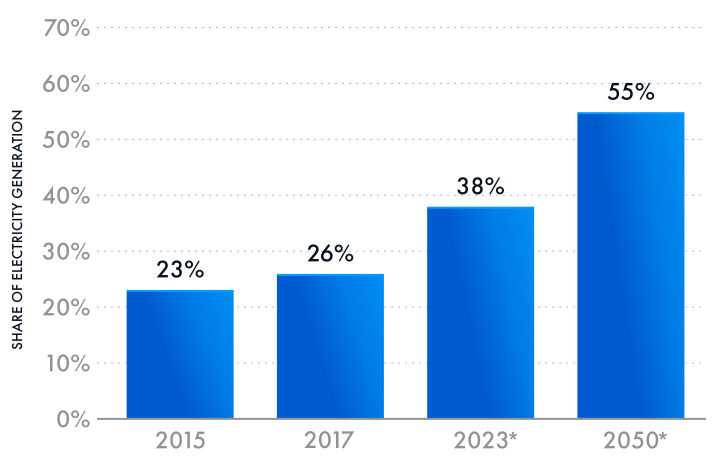
Battery storage technology enhances the efficiency of renewables. It makes them a reliable energy source for a variety of applications, including households with photovoltaics (PVs), off-grid commercial facilities, and isolated communities, such as islands and remote rural areas. Smart grids located in Rokkasho, a village in Japan, store solar and wind energy using a large-capacity BESS based on sodium-sulfur batteries. Currently, there are 92 wind power generation facilities and 3 solar power plants with a total capacity of 313,350 kW.
A BESS assists grid-tied and hybrid solar and wind systems with energy time-shift and demand-side management. For example, in windy weather, the system can power homes and charge batteries during on-peak and off-peak times respectively. Later, the battery energy storage system wind power can be used when the electricity demand is high and the variable energy resource is unavailable. Such a system has been installed and is running successfully in the Faroe Islands. Now, wind turbines generate power that covers about 50% of the islands’ energy needs.
Transmission and Distribution (T&D) Deferral
Battery energy storage can eliminate the need to build new transmission and distribution systems or update existing T&D assets that lack capacity or become obsolete. By storing excess energy and providing reserve capacity, a BESS can take the load off overloaded T&D lines and prevent congestion in transmission systems.
Microgrids
A BESS is an essential part of microgrids—distributed power networks that can be connected to the utility grid or totally independent. Standalone microgrids located in remote regions can rely on battery storage systems integrated with intermittent renewable energy sources. Such solutions enable smooth power generation and help avoid heavy expenses and air pollution associated with diesel generators.
BESSs find wide use in different industries and application areas. For example, front-of-the-meter (FTM) applications comprise battery storage systems in electric power systems, such as utility-scale generation and energy storage facilities as well as transmission and distribution lines. Behind-the-meter (BTM) applications embrace transportation, including electric vehicles and marine systems, residential, commercial, and industrial battery storage solutions.
The Vistra Moss Landing Energy Storage Facility in California, USA, is the world's largest battery storage system. The 400 MW/1600 MWh BESS was commissioned to work in December 2020. The storage capacity is expected to reach 750 MW/3000 MWh by the summer of 2023.
Vistra, the retail electricity and power generation company previously criticized for climate pollution, is shifting its focus to renewable energy, doing its part to protect the environment and create new jobs.
Some of the world’s largest battery energy storage systems are the Alamitos Energy Center, Gateway Energy Storage (US), Hornsdale Power Reserve (Australia), Minety Battery Energy Storage Project (UK), Buzen and Rokkasho battery power plants (Japan), Korea Zinc Energy Storage System (South Korea), and Kunshan Energy Storage Power Station (China).
In 2022, 4,027 MW / 12,155 MWh of battery energy storage was deployed in the US, compared to 3,000 MW / 9,500 MWh added to the grid in 2021. As analyzed by Frost & Sullivan, the decrease in technology cost and rapid spread of renewables will boost the global grid battery storage capacity to 134.6 GW by 2030.
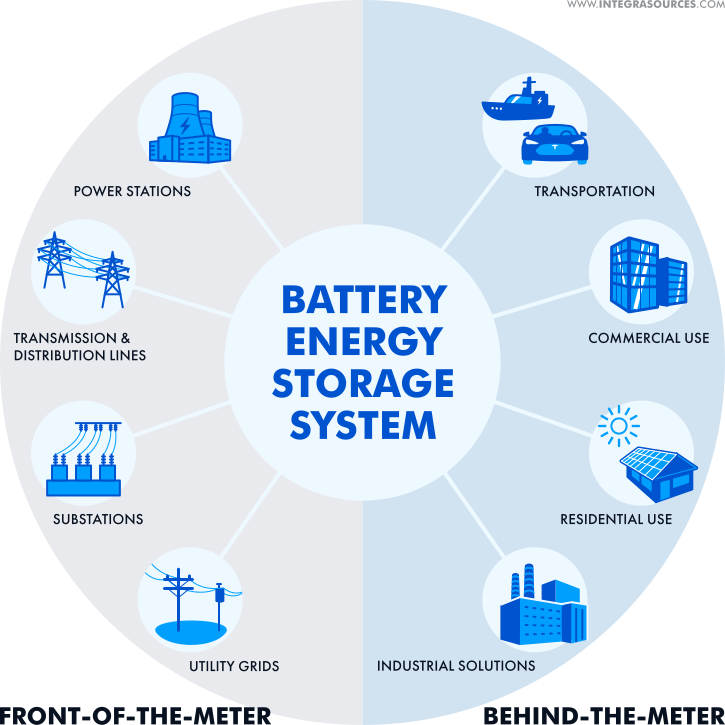
BESS: To Buy or Not to Buy
The global energy storage market offers a great choice of off-the-shelf battery energy storage systems. They vary in battery chemistry, scale, functionality, intended use, and price. Here are some of the key BESS market players:
- NextEra Energy - This company is the world’s largest generator of renewable energy from wind and solar. It is one of the global leaders in battery energy storage capacity and number one in the US with the largest amount of operational storage.
- ABB - This Swedish-Swiss multinational corporation manufactures battery energy storage systems for solar applications. Their product range includes Li-ion battery-based modular solutions for households, smart transportation systems, utilities, and industrial applications.
- BYD (China) - One of the largest manufacturers of all types of rechargeable batteries worldwide, BYD produces energy storage systems for various applications. Their product line comprises large-scale utility BESSs, modular battery-based ESSs for commercial use, and MINI ES products—small-sized battery storage devices.
- Panasonic (Japan) - Panasonic is the manufacturer of EverVolt home battery storage solutions that can store solar power with 11 to 120 kWh storage options. EverVolt uses Panasonic Li-ion battery cells.
- Toshiba (Japan) - Toshiba offers SCiB systems—medium and large-scale Li-ion battery energy storage solutions. These systems serve public, commercial, and industrial needs.
- Fluence - This is a joint venture between Siemens (Germany) and AES (USA) that offers three battery energy storage products: Gridstack (grid-scale energy storage system for industrial applications), Sunstack (solar energy storage system), and Edgestack (commercial energy storage system).
- Samsung SDI (South Korea) - Samsung is one of the leading global manufacturers of Li-ion rechargeable batteries. Their battery energy storage systems range from kWh to MWh and find use in homes, power plants, utilities, and commercial facilities.
- LG Chem (South Korea) - LG provides battery solutions that accumulate and store solar energy to power homes without using electricity from utilities. The LG Home Battery RESU systems have a compact size and use lithium-ion batteries.
- General Electric (USA) - GE manufactures a broad spectrum of battery energy storage systems that can be used for standalone applications and integrated hybrid solution applications, relying on solar, wind, and thermal power.
- Hitachi (Japan) - Hitachi produces modular battery energy storage systems with Li-ion batteries for indoor and outdoor locations. These systems are designed for commercial and industrial applications and can be combined with solar and wind energy sources as well as diesel generators.
- Tesla (USA) - Powerwall and Powerpack are the two major battery storage products made by Tesla. Both systems are based on rechargeable lithium-ion batteries. Powerpack aims at commercial and industrial applications while Powerwall can be integrated with solar energy for residential use.
- NEC Corporation - This multinational Japanese corporation produces battery storage containers ranging from 20 to 53 feet. NEC BESSs are based on their proprietary software platform called AEROS®.
- Johnson Controls - This is a US manufacturer of containerized ESSs based on lithium-ion batteries. Their distributed energy storage systems are designed for applications that supply from 50 kWh to 200 kWh and from 150 kWh to 5,000 kWh.
The global battery energy storage market is abundant in offers. As battery costs tend to fall, ready-made BESSs become more affordable to consumers. According to Statista, the price for lithium-ion batteries (that prevail in battery-based energy storage) has dropped by 90% in the past 11 years—from $1,220 in 2010 to $132 in 2021 per kilowatt-hour. But at the end of the day, the battery price will depend on the project size and storage capacity—small-scale projects will be charged higher than the average price.
Apart from the batteries, the total battery energy storage system cost consists of the cost of an energy management system, a BMS, a power conversion system, or inverter, and other components. Utilizing an out-of-the-box BESS may also entail expenses on installation, operation, maintenance, and warranty. For example, Tesla’s Powerwall provides 13.5 kWh of usable storage capacity, and its price can amount to $10,500, including the solar panel system and installation costs. Panasonic EverVolt allows for storing between 11.4 kWh and 17.1 kWh of energy, which will cost from $15,000 to $20,000 with solar panels, installation, and set up.
When choosing a battery energy storage system, you should consider plenty of factors other than its cost. They include:
- system completeness and availability of related subsystems and supporting equipment;
- chemistry, safety, and other characteristics of the battery;
- quality, availability, and supply continuity of hardware components;
- software reliability.
Thus, BMS software plays a significant role in the overall performance of a battery storage system as it is responsible for charging and discharging along with battery safety.
Once you are set to buy an off-the-shelf battery energy storage system, make sure you or your staff have enough expertise and qualifications to check the quality and completeness of the entire system before making a purchase and supplying it to your customer.
Setting up, maintaining, and supporting a BESS may also require personnel training on your side unless you’re ready to pay for these services to the BESS provider. When buying a battery storage device, make sure the manufacturer offers a warranty that covers the repair or replacement of the system and its components in case of failure.
Purchasing an out-of-the-box BESS can definitely save your time, especially if you need a turnkey solution with no specific consumer requirements for the system. With a rich selection of battery energy storage products on the market, there is a high chance of finding a reliable manufacturer and a suitable option that could meet your customers’ needs.
Conversely, ready-made systems may have unreasonably priced electronics, pre-installed software of poor quality, and unnecessary features that add to the cost. They may also lack features desired by the end user or fail to satisfy the consumer’s industry and business niche demands or operating conditions and location requirements. In addition, not all BESS suppliers provide all-in-one solutions, and purchasing components and subsystems from different manufacturers can result in serious compatibility and interconnection issues. Developing a custom battery energy storage system can become an alternative that is worth looking at.
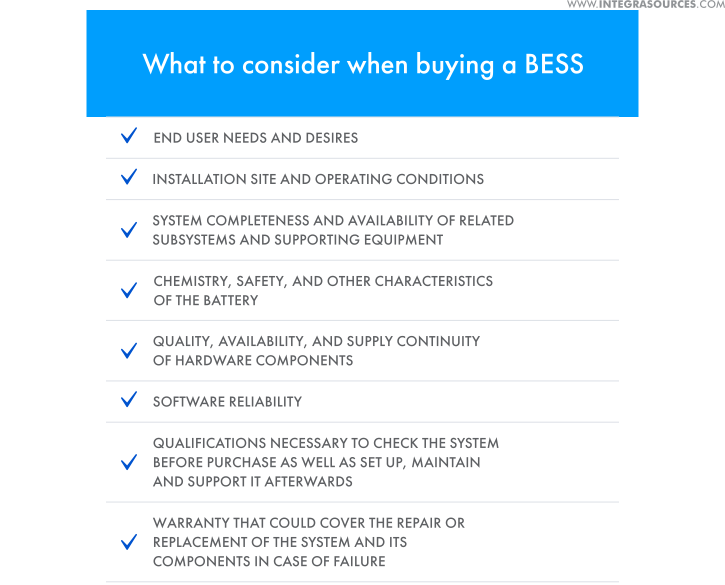
Building a BESS: Pros and Cons
Tailor-made BESSs can make up for what’s lacking in out-of-the-box solutions offered by major battery storage systems providers. So, they can meet the exact needs of your potential consumers. However, implementing a custom product is a time-taking and resource-consuming task. Building a battery energy storage solution belongs to large-scale, long-running projects that can last for months or even years.
A BESS is a complex, multilayer engineering system, so developing a battery-based storage solution from the ground up requires deep knowledge in various fields, including battery technologies, power electronics, and embedded software development. In our upcoming articles, we’ll cover challenges associated with developing and implementing battery energy storage systems.
Choosing the right development team is half the battle; that’s why it’s essential to hire well-trained professionals with relevant experience. Creating a battery energy storage system from scratch takes specialists in electronic design, electrical engineering, low-level firmware, high-level software, and mechanical engineering for enclosure design.
The Integra Sources team could be the right fit for your project. We design PCBs for battery management, bi-directional power conversion, energy management, and safety systems of a BESS. Our engineers implement monitoring and control software and provide online data communication for remote BESS management. We create scalable battery energy storage solutions with fast response time, quick ramp rate, and high-efficiency power supply. Integrated with either electrical grids or renewables, our BESSs can serve for load management, power backup, frequency and voltage regulation, energy time-shifting, and many other purposes.
Manufacturing is another important challenge you’ll have to face when making your own battery energy storage product. The BESS manufacturing process involves a diversity of tasks that can be carried out at different production facilities. So, synergy is the key to efficient BESS manufacture.
You’ll have to take care of the product certification too. Apart from international standards, such as IEC, ISO, IEEE, and UL, a BESS is highly likely to need to meet specific national standards and certification requirements in each particular country. For example, in the United States, an energy storage system must also conform to the regulations of the Federal Energy Regulatory Commission (FERC), the Department of Energy (DOE), and some regulatory agencies at the state level.

In October 2019, Australia and New Zealand developed AS/NZS 5139:2019—a joint standard that sets general installation and safety requirements for battery energy storage systems. In addition, Australian BESS manufacturers must comply with a number of other national and international codes and standards.
Certification criteria may also depend on the industry and application area of a BESS. For example, DNV provides a recommended practice that contains guidelines for design, performance, operation, maintenance, and safety for energy storage used in marine systems. The document comprises specifications for charge/discharge rate, SOC, SOH, DoD, and many other system parameters and operating conditions.
The engineering team engaged in BESS development must be well-versed in the certification requirements and applicable standards. This helps mitigate risks in the system’s design and delivers a high-quality product to your end user on time and within budget.
Despite the challenges, designing a bespoke BESS can enhance usability, reduce operating costs, and improve the reliability of the system. After drilling down the market, you can heed the customers’ needs, consider the shortcomings of off-the-shelf BESSs, and create highly sought-after battery energy storage solutions.
Implementing your own product makes you independent of any particular BESS provider and its services. You can set up, maintain, support, and deliver other services to your customers in a prompt manner and without intermediaries.
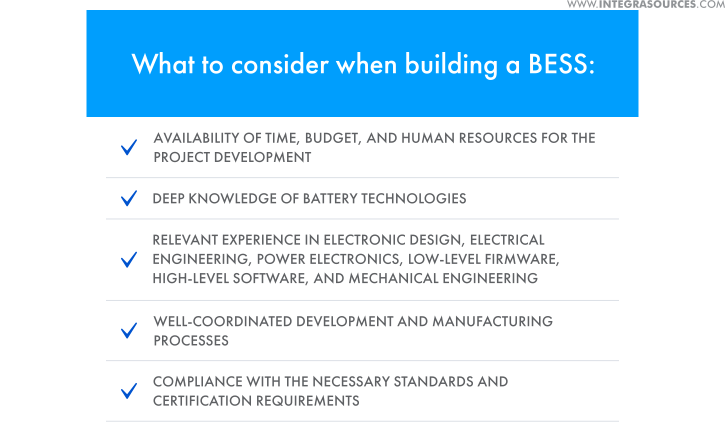
Conclusion
A BESS is a multi-component energy storage system able to store varying amounts of electrochemical energy and use it later for a range of purposes—be it peak shaving, energy arbitrage, or a black start.
The advances in battery technology make a BESS a light and affordable solution for both residential and commercial use, including smart homes, large-scale industrial facilities, and utility grids. Buildings, villages, towns, and even entire islands can employ battery storage integrated with green energy for a reliable, self-sufficient power supply.
BESS manufacturers offer a wealth of options with various storage capacities and for any application and budget. However, purchasing an off-the-shelf system demands strong knowledge of the technology, and a ready-made BESS may not meet the specific requirements of an end user.
Despite the design complexity and long project duration, a bespoke BESS can cater to your customer’s industry needs, solve their problems, and cut down on operational costs. Finding the right development team can assist you in building a well-functioning customized solution. Integra has deep expertise in battery storage technologies, including their hardware and software components. Depending on the consumer requirements, we can calculate the performance characteristics and design costs of a BESS, develop electronics, write firmware, and build apps to manage the system and communicate with it remotely. By choosing the right components and design techniques, we’ll make your product reliable, highly efficient, and standards-compliant. So if you’re looking to create a battery energy storage system or need an expert opinion on its development and implementation, reach out to us to get things started.
Share this article


Related
materials
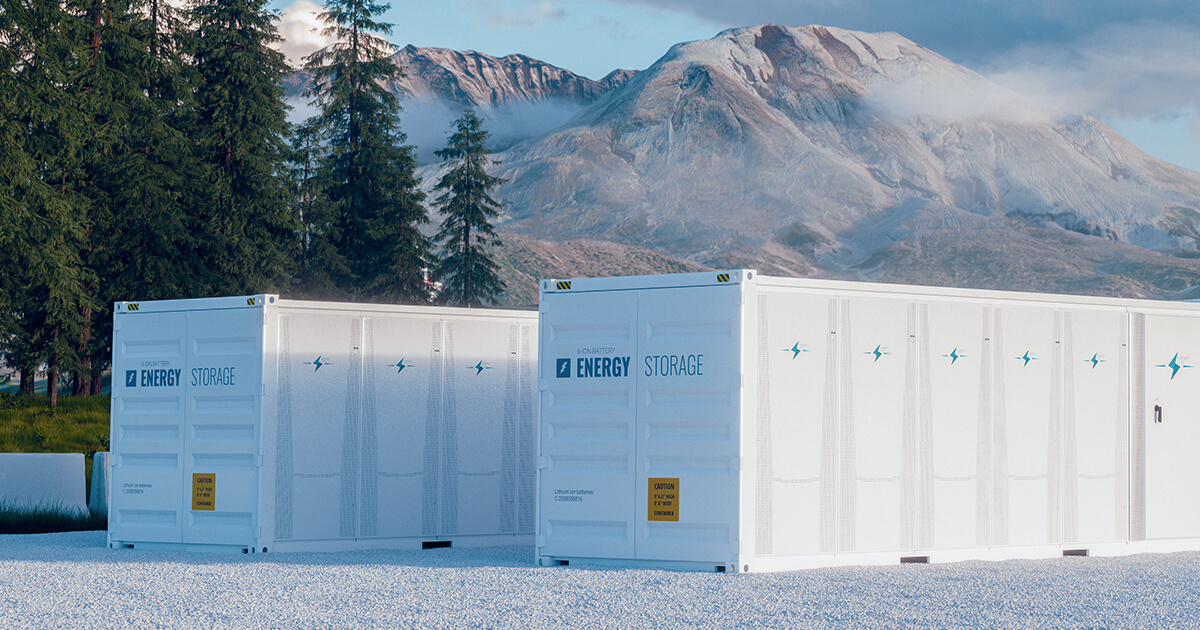
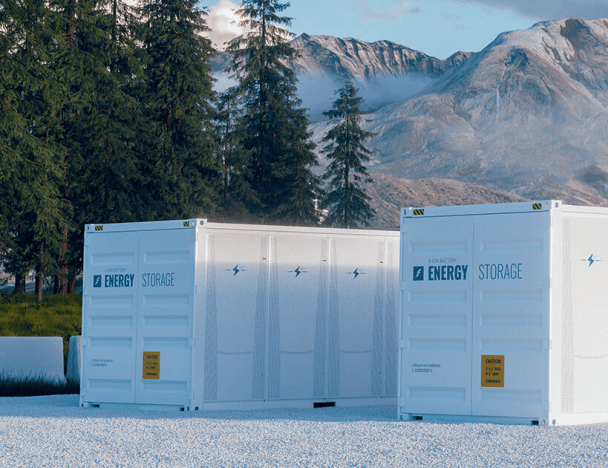
Battery Management System Development
Integra Sources reviewed the hardware and software of the battery management system. We provided PCB, firmware, app, and server development.
LEARN MORE
LEARN MORE
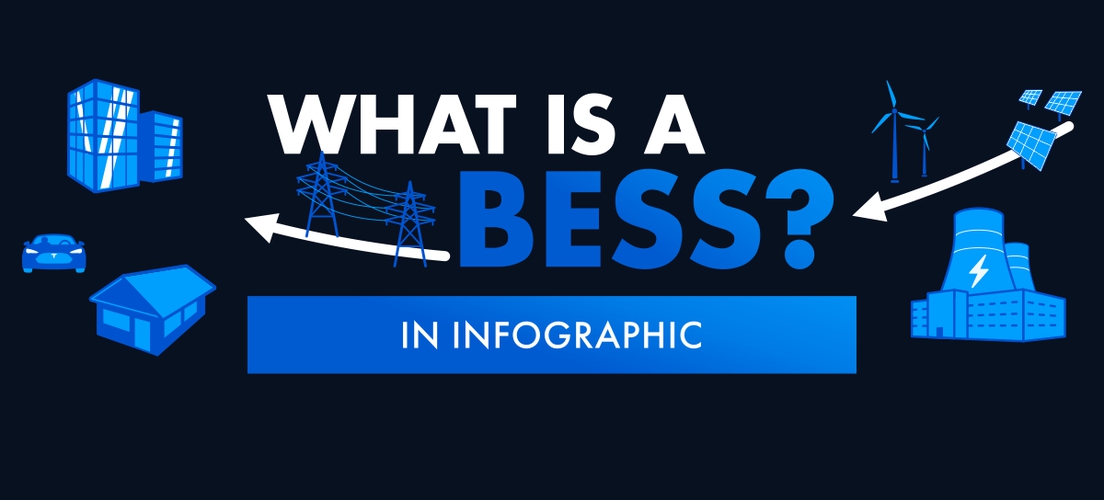

BESS: The infographic
We have collected for you the most important information about the BESS in one infographic.
LEARN MORE
LEARN MORE
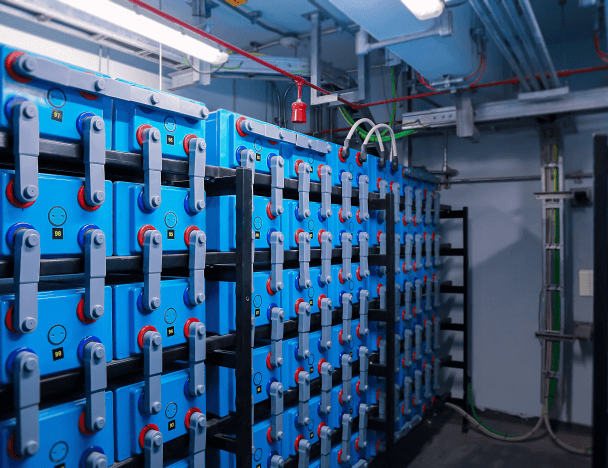
Technology Overview on Software Development for Battery Management Systems (BMS)
A battery management system or BMS performs many functions. It can help you estimate the charging level of your battery...
LEARN MORE
LEARN MORE


